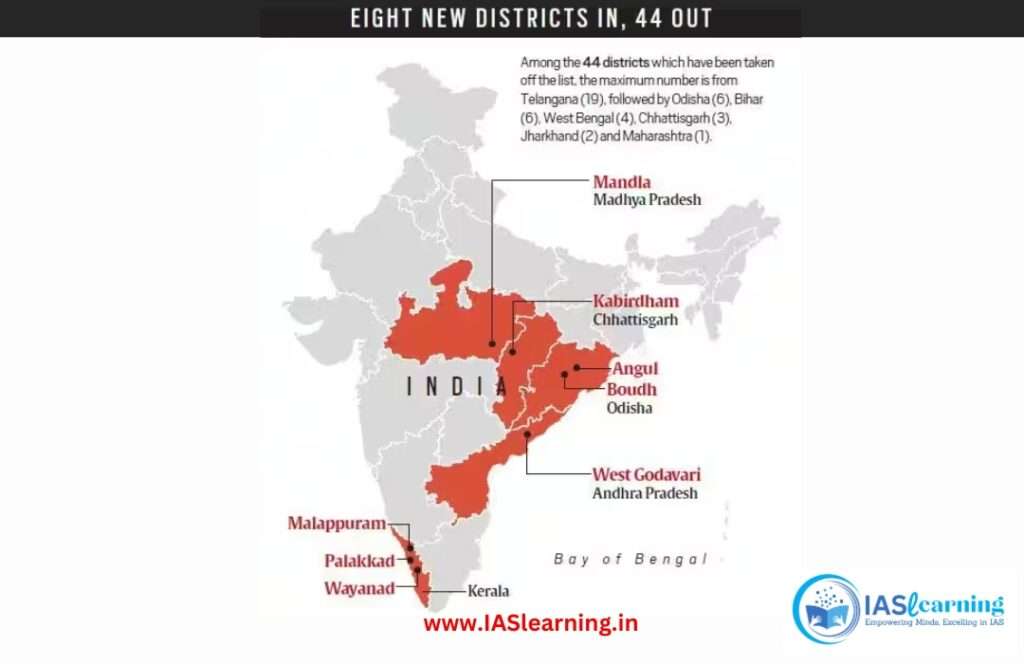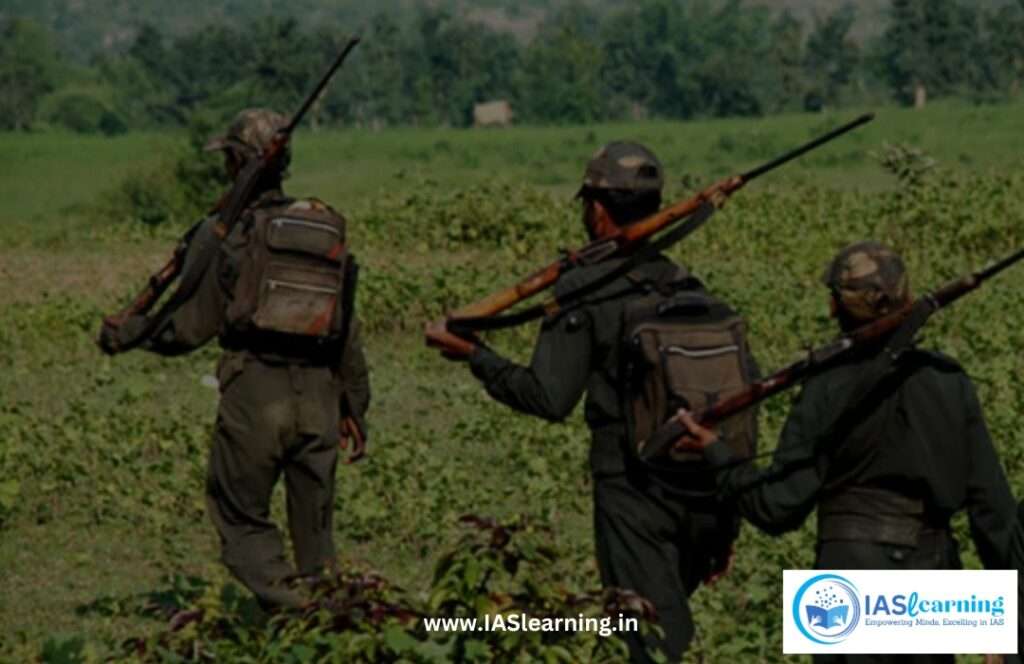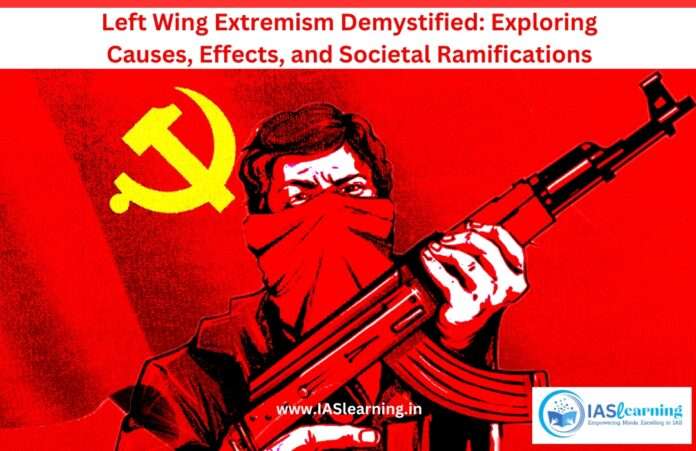Left Wing Extremism and Naxalism in India
About Left Wing Extremism
- Left-wing extremists, popularly known as Maoists worldwide and as Naxalites/Naxalism in India, has been a major threat to India since the 1960s.
- The term Naxalism derives from the name of the Naxalbari village in West Bengal where a peasant revolt took place against local landlords over a land dispute in 1967.
- The origins of Left Wing Extremism (LWE) in India goes back to the Telangana peasant rebellion (1946-51), the movement was at its peak in 1967, when the peasants, landless labourers, and Adivasis raided the granaries of a landlord in the Naxalbari village in West Bengal.

Status of Left Wing Extremism in India
- Incidents of Naxal violence in the country have come down by 77% between 2009 and 2021. Similarly, consequential deaths (civilian + security forces) have declined by 85% from an all-time high of 1005 in 2010 to 147 in 2021. In the year 2021, 90 % (45 out of 50) of the total deaths of security personnel in the country were in Chhattisgarh. Jharkhand is the only state which recorded death (5) of security personnel in the year 2021 apart from Chhattisgarh
- There has also been a decline in the geographical spread of violence, as only 46 districts reported LWE-related violence in 2021, compared to 96 districts in 2010.
Reasons for Left Wing Extremism:
- Tribal discontent:
- The Forest (Conservation) Act, 1980 deprives tribals, who depend on forest produce for their living, from even cutting a bark.
- Massive displacement of tribal population in the naxalism-affected states due to development projects, mining operations and other reasons.
- No Follow-Up from administration:
- It is seen that even after police takes hold of a region, administration fails to provide essential services to the people of that region.
- Confusion over tackling naxalism as a social issue or as a security threat.
- State governments considering naxalism as the central government’s issue and thus are not taking any initiatives to fight it.
- Lack of Livelihood:
- People who do not have any source of living are taken into Naxalism by Maoists.
- Maoists provide arms and ammunition and money to such people.
- Governance related issues:
- Government measures its success on the basis of the number of violent attacks rather than the development done in the Naxal-affected areas.
- Absence of strong technical intelligence to fight with Naxalites.
- Infrastructural problems, for instance, some villages are not yet connected properly with any communication network.
Fundamental traits and features of Left Wing Extremism include:

- Marxist-Leninist-Maoist ideas, which support the empowerment of underrepresented and oppressed groups in society, such as workers and peasants, frequently influence LWE groups. They critique imperialism, capitalism, and what they see as unfair class divisions.
- Armed Conflict: Numerous LWE organizations wage an armed insurgency against the government and its institutions, frequently employing guerrilla warfare techniques. They want to create “liberated zones” where they may operate and carry out their ideals in isolated or rural locations.
- Anti-Government: LWE organizations view the current state and government as oppressive apparatuses that uphold the present quo. They aim to take their own systems of government in place of these ones.
- Focus on Peasants and Tribes: LWE groups frequently target rural and tribal regions because they think there is more room for mobilization there and because social inequality and land rights concerns are more pressing there.
- Social Justice: LWE organizations frequently assert that they stand out for the rights of underprivileged groups including tribal communities, landless peasants, and other underprivileged populations.
- International Links: A few LWE organizations take their cues from global communist movements and ideology. They could be connected to movements of a similar nature elsewhere.
- Violence: LWE organizations regularly use violence to further their objectives. Attacks on infrastructure, security personnel, elected politicians, and those seen to be cooperating with the state are all examples of this violence.
Reason for Left Wing Extremism in India

- Socio-Economic Inequities: Left-wing extremism has been fueled by pervasive socio-economic inequality, particularly in rural regions. The lack of access to essential amenities, uneven access to land, landlessness, and labor exploitation have all led to the unrest among society’s disadvantaged and marginalized groups.
- Land Conflicts: Land disputes have been a crucial catalyst for left-wing extremism. These disputes might be about ownership, control, or distribution. Conflicts and opposition have resulted from disagreements between indigenous people and significant landowners as well as problems with the purchase of land for development initiatives.
- Exploitation of Tribal groups: Tribal groups make up a sizable section of the populations in places afflicted by left-wing extremism. Leftist beliefs have gained popularity in part because historical exploitation, relocation brought on by construction projects, and the loss of traditional livelihoods have exacerbated frustrations.
- Lack of Effective government: Communities in many impacted regions have been disillusioned and vulnerable to extremist beliefs that offer an alternative system as a result of corruption, ineffective basic service delivery, and a lack of effective government.
- Failure of Land Reforms: Despite efforts to enact land reforms, there have been occasions where their implementation has been insufficient or inefficient. Due to this, disadvantaged populations and landless peasants have not experienced any significant improvement.
Government Step for Left Wing Extremism

- Eklavya Residential Model School: More than 100 Eklavya Residential Model Schools were sanctioned in 21 years prior to 2019, while in the past three years, 103 have been sanctioned.
- So far, 245 Eklavya schools had been sanctioned in 90 LWE-affected districts and 121 of them were now functional.
- ROSHNI is a special initiative under, Pandit Deen Dayal Upadhyaya Grameen Kaushalya Yojana (Formerly Ajeevika Skills), launched in June 2013 for training and placement of rural poor youth from 27 LWE affected districts in 09 States.
- Road Connectivity: Construction of 17,462 km of roadways had been sanctioned to improve road connectivity, of which work on about 11,811 km had been completed.
- Aspirational Districts Programme: Launched in 2018, it aims to rapidly transform the districts that have shown relatively lesser progress in key social areas.
- SAMADHAN doctrine is the one-stop solution for the LWE problem. It encompasses the entire strategy of government from short-term policy to long-term policy formulated at different levels. SAMADHAN stands for-
- S- Smart Leadership,
- A- Aggressive Strategy,
- M- Motivation and Training,
- Actionable Intelligence,
- D- Dashboard Based KPIs (Key Performance Indicators) and KRAs (Key Result Areas),
- H- Harnessing Technology,
- Action plan for each Theatre,
- N- No access to Financing.
Way Forward for Left Wing Extremism
- Innovative strategies must be implemented to stop IED-related occurrences, which have recently resulted in a large number of fatalities.
- The development of local police forces’ capabilities and modernisation should be prioritized.
- States should justify their surrender policy in order to include innocent people who have fallen victim to LWE.
- States must also establish a targeted, time-bound strategy to entirely eradicate LWE groups and guarantee the overall development of the impacted areas.

